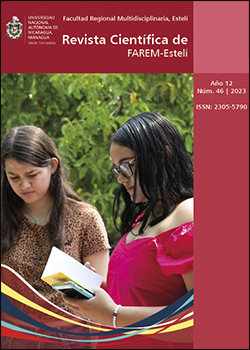The minidictionary as a metacognitive strategy through the use of the tic classroom for teaching 10th grade Nahuatl substratum, Rigoberto Lopez Perez High School, Managua, Nicaragua
DOI:
https://doi.org/10.5377/farem.v12i46.16479Keywords:
Substrate, Nahuatl, lexicon, strategy, minidictionaryAbstract
The Nahuatl substratum in Nicaragua is part of its identity, therefore, it should be widely present in student education, as part of the linguistic and cultural heritage of the aboriginal peoples who settled in the country. In the MUP (Macro Pedagogical Unit) of MINED (Ministry of Education of the Republic of Nicaragua), the teaching of the Nahuatl language in 10th grade students is oriented as part of the cultural and linguistic rescue of Nicaraguan history. Currently, these terms are falling into disuse due to transculturation by the mass media, technological influence, and the strong influence of standard Spanish. Likewise, this article shows different lexical studies that express the importance of reinforcing the rescue of the Nahuatl substratum. It is also necessary to search for different strategies that help in the learning of Nahuatl words, such as the mini-dictionary that promotes in a creative, playful and entertaining way the taste and learning of these terms. This article aims to promote the mini-dictionary as a metacognitive strategy through the use of the ICT classroom for the teaching of the Nahuatl substratum, from a didactic sequence, in 10th grade students of the Rigoberto López Pérez Institute, in the year 2022. Therefore, it is essential to teach this content with varied, flexible, technological and creative strategies so that students learn Nahuatlisms in a substantial, meaningful and contextualized way.
Downloads
References
Alonso De Molina. (2006). “Aquí Comienza Un Vocabulario En La Lengua Castellana Y Mexicana”. http://Www.Cervantesvirtual.Com/Obra/Aqui-Comienca-Sic-Un-Vocabulario-Enlalengua-Castellana-Y-Mexicana--0/
Arellano Oviedo, F. (2007). Diccionario del español de Nicaragua. DEN. https://isbn.cloud/9789992459898/diccionario-del-espanol-de-nicaragua/
Carvajal Muñoz, I., Marín Córdoba, S. & Ortega Valverde, J. (2014). El uso del diccionario en el aula de educación primaria. http://www.redalyc.org/articulo.oa?id=44247251005
Carrasco, S. (2005). Metodología De La Investigación Científica. San Marcos
Castilla- Corzo, et al. (20220). La chicha, producto gastronómico y ritual: caso chorro de Quevedo (Colombia y Otavalo (Ecuador. Revista Turismo y Sociedad. https://revistas.uexternado.edu.co/index.php/tursoc/article/view/6272/8863
Collado, C., Baptista, P., & Sampieri, R. (2006). Metodología de La Investigación Cuarta edición. Graw Hill.
Cortez Padilla y Cruz Vilches (2015). Variación lingüística del sustrato náhuatl y el español general o estándar en los hablantes de Tisma-Masaya: un enfoque sociolingüístico. https://repositorio.unan.edu.ni/10574/1/9187.pdf
Diccionario etimológico (2023). Etimologías, latín, chistes, refranes, ciudades. https://etimologias.dechile.net/?canica
Real Academia Española (2022). Diccionario de la lengua española (edición de tricentenario) https://dle.rae.es/chicha
Diccionario Larousse de Cocina (2023). Diccionario gastronómico. https://laroussecocina.mx/palabra/plancha/
Díaz, F., y Hernández, F. (2002). Estrategias docentes para un aprendizaje significativo. McGraw-Hill. https://buo.mx/assets/diaz-barriga%2C---estrategias-docentes-para-un-aprendizaje-significativo.pdf
Figueroa, D., Flores, C. y Vásquez, J (2019). Fue un estudio acerca de la vitalidad léxica del sustrato náhuatl en los hablantes del barrio Monimbó de Masaya. Se realizó desde un enfoque sociolingüístico. Tesina para optar a licenciatura en Ciencias en Educación. Universidad Nacional Autónoma de Nicaragua http://repositorio.unan.edu.ni/10724/1/447.pdf
Goleman, D. (2017). Inteligencia Emocional. Editorial Kairós.
Hernández, R. (2006). Metodología De La Investigación. Mc Graw.
Hingarova, V. (2012). “La Vitalidad Del Náhuatl En México Contemporáneo”. Memoria Académica. http://Www.Memoria.Fahce.Unlp.Edu.Ar/Trab_eventos/Ev.3788/Ev.3788.Pdf
Incer Barquero, J (1985). Toponimias Indígenas de Nicaragua. Libro Libre. Instituto Nacional De Estadísticas censos. https://Www.Enriquebolanos.Org/Media/Publicacion/Ll_toponimiasindigenasnicaraguaj
Lara Gómez, y Orozco Palacio (2015). También acerca de la vitalidad léxica de los nahuatlismos en los hablantes del municipio de Cárdenas, Rivas. Un enfoque sociolingüístico. http://www.redalyc.org/articulo.oa?id=44247251005
Largaespada, D. (2016). El Náhuatl En El Español De Nicaragua. https://Www.Managuafuriosa.Com/La-Vitalidad-Del-Nahuatl-Espanol/
Navarro, N. (2017). Secuencia didáctica. https://Www.Definicionabc.Com/Comunicacion/Secuencia-Didactica.Php
Montano Montano, C. y Ochoa Romero. M. (2018). Acerca de las creencias y actitudes lingüísticas de los estudiantes sobre el sustrato náhuatl en el español del Salvador, esta investigación realizada en la universidad del Salvador. https://www.google.com/url? sa=t&source=web&cd=&ved=2ahUKEwjY-
Mántica, C. (1989). El habla nicaragüense y otros ensayos. Asociación Libro Libre.26. https://Www.Enriquebolanos.Org/Media/Publicacion/Ll_hablanicaraguenseotros Ensayoscarlosmantica.Pdf
Mántica, C (2004). Introducción al habla nicaragüense. Managua: Hispamer. https://Isbn.Cloud/9789992457320/Introduccion-Al-Habla-Nicaraguense/
Martínez, A. Xilomen, A., Flores, E., y Juan, C. (2017). Estudio De La Vitalidad Léxica del Sustrato náhuatl en los Hablantes del Barrio Monimbó de Masaya: Un Enfoque Sociolingüístico. http://Repositorio.Unan.Edu.Ni/Id/Eprint/10549
Sampieri, C. (1998). Metodología de la Investigación. Segunda Edición. McGraw Hill
Silva, F. (1999). La Lengua De Nicaragua: Academia Nicaragüense De La Lengua. https://Isbn.Cloud/9789992404294/La-Lengua-Nuestra-De-Cada-Dia/
Schunk, D. (2012). Teorías del Aprendizaje: una perspectiva educativa. https://biblat.unam.mx/es/revista/investigacion-en-educacion-medica/articulo/schunk- dale-teorias-del-aprendizaje-una-perspectiva-educativa-editorial-pearson-sexta-edicion- 2012
Valdés, G (2004). Heritage Lenguaje Studensts Profiles and Posibilites. Https://Www.Taylorfrancis.Com/Chapters/Edit/10.4324/9780203122419-10/Heritage-Language-Students-Profiles-Possibilities-Guadalupe-Vald%C3%A9s
Woolfolk, Anita E. (1999). Psicología Educativa. 7ª Ed. Prentice Hall.Thouvenot, M. y Manríquez, J. (2015). Diccionario de nahuatl y español. Universidad Nacional Autónoma de México https://historicas.unam.mx/publicaciones/publicadigital/libros/diccionario/diccne00.pdf
Zamora, Z (2020). Situación actual del sustrato náhuatl en el español de Nicaragua. Revista Lengua y Literatura. https://Www.Camjol.Info/Index.Php/Rll/Article/View/10123.
Published
Issue
Section
License
Copyright (c) 2023 Revista Científica de FAREM-Esteli

This work is licensed under a Creative Commons Attribution-NonCommercial-ShareAlike 4.0 International License.



